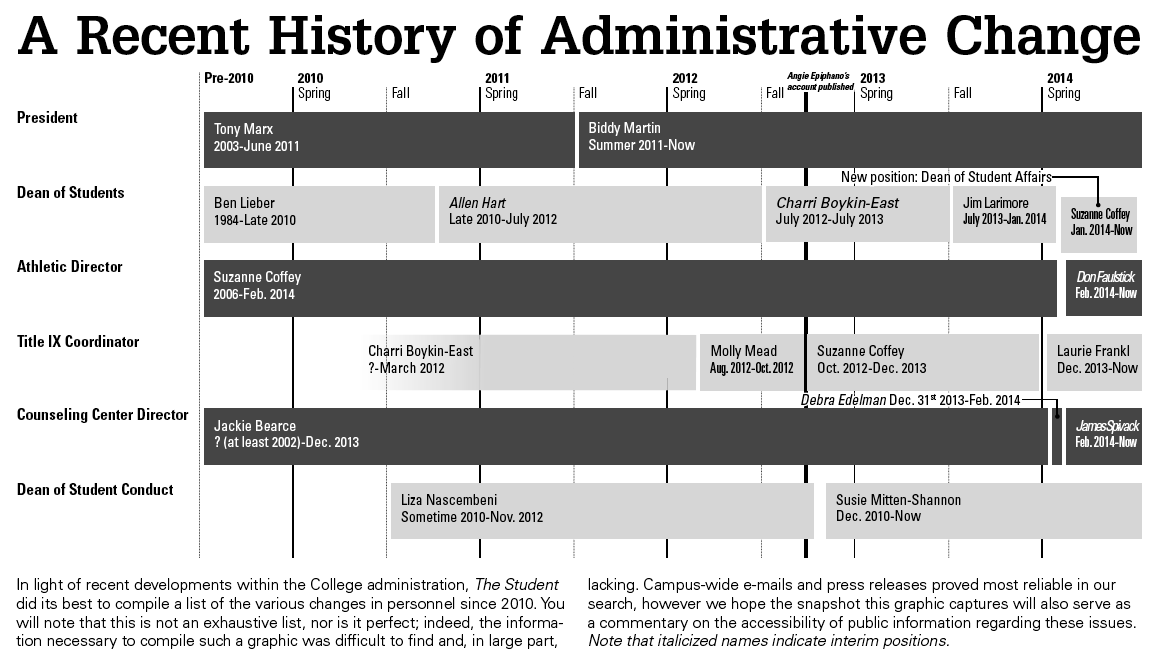

On Monday, Dean Larimore resigned as the College’s Dean of Students. The Student sincerely regrets his leaving. It was only a year ago, last February, that Dean Larimore was selected through an extensive search process to be the College’s new Dean of Students. Since then, he has established a genuine and meaningful relationship with the students, and many cannot help but feel that his resignation is both abrupt and perplexing.
In recent history, the College has gained, lost and reassigned an innumerable number of administrators. The turnover in administrative staff is alarmingly high, as illustrated in the infographic featured here.
This is not an effective way of running an organization. The problems that confront the College require long-term and visionary solutions. They require administrators who will see the process from start to finish. The high turnover in administrative staff hinders the development of institutional memory, which is crucial to resolving the entrenched cultural and structural issues that the College faces. The College expends a tremendous amount of effort meticulously selecting new administrative hires. When new administrators leave after only a brief period, the College must expend further resources searching for and hiring replacements. This is not sustainable, and after a certain point, it becomes too urgent or too expensive to make a carefully deliberated and judicious decision.
It seems that the College’s staff turnover is exceedingly high relative to other organizations. A quick Google search reveals that The Dean of Williams College keeps their position for three years before undergoing review. Tim Foster — Dean of Student Affairs at Bowdoin — has kept his position since 2006 and Swarthmore’s Liz Braun has been Dean of Students since 2010. Amherst, since 2010, is now onto number five.
If a corporation were to have as a high turnover in upper management as the College does in administrative staff, we would not hesitate to call it a corporation in distress. While Amherst is not a corporation with shareholders to answer to, it does have students. And with each turnover, we indeed are growing more distressed.
The College is highly receptive of student feedback and eager to send out constant updates when hiring new administrators. In contrast, when an administrator leaves, the College continues to inform students with a cryptic brevity.
Dean Larimore’s decision to leave the College should be respected, and students should not groundlessly speculate on his personal reasons for leaving. Nonetheless, many cannot help but feel left in the dark. Speculation does not abound when there is transparency, and if anything, students’ current inclination to speculate is a result of the administration’s opacity and inability to once again deliver satisfactory answers. Why does it appear so difficult for Amherst to retain critical administrative staff? What are its causes and how can we fix it? Dean Larimore’s resignation seems surprising and unusual, yet it is also, paradoxically, characteristic of a pattern in the administration that is gradually becoming more and more evident.
"Innumerable" may be the wrong word choice when you have a graphic showing the specific number of administrators who have left. "Innumerable" implies an inability to count something due to how numerous it is. You just counted the thing you're claiming can't be counted though. "Several", or even "many' would be a better adjective. The op-ed starts to make a good point - don't resort to hyperbole to get there.
- Amherst Alum